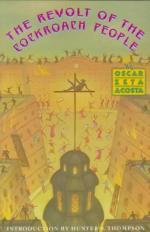|
This section contains 437 words (approx. 2 pages at 400 words per page) |

|
The Revolt of the Cockroach People Summary & Study Guide Description
The Revolt of the Cockroach People Summary & Study Guide includes comprehensive information and analysis to help you understand the book. This study guide contains the following sections:
This detailed literature summary also contains Topics for Discussion and a Free Quiz on The Revolt of the Cockroach People by Oscar Zeta Acosta.
The Revolt of the Cockroach People is the fascinating story of Chicano lawyer Buffalo Zeta Brown, written by his son, Oscar Zeta Acosta. Brown became involved with the Chicano Militants when he moved to Los Angeles in 1968. He originally went to Los Angeles looking for a story to write. Brown wanted to write a book. He didn't want to work as a lawyer but that isn't the way it worked out.
Brown spent three years with the Chicano Militants. This book goes behind the scenes of the radical Chicano movement in the barrio of Tooner Flats in East Los Angeles. The reader goes inside the group with Brown and becomes familiar with the various characters. Not only did Brown function as the groups' lawyer, he became one of them, helping to organize the protests and marches.
His first march with the group was the protest at the Garfield School the day after he was introduced to them. He looked at what was happening and wondered what his role should be. The leaders were eventually indicted on charges of conspiracy to disrupt the schools. Brown defended them and eventually won.
The Militants also tackled the Catholic Church and disrupted Masses on Christmas Eve and Christmas Day in 1969. This resulted in the St. Basil Twenty-One case. There were also other cases such as the Robert Fernandez case. The boy was found hanged in jail. His family felt the boy was murdered and went to Brown. Brown got a second autopsy and a hearing, but not the charge of murder he was looking for.
When Brown was in Acapulco for several months, the East Los Angeles riots occurred. Reporter Roland Zanzibar was killed during the riots. A group of militants were arrested in conjunction with the riots. They were known as the Tooner Flats Seven and Brown won a verdict of innocent for them in the year-long trial. Along the way, he challenged the way in which Grand Juries were selected and won the right to question judges.
Brown's involvement with the Chicano Militants wasn't strictly as legal adviser. He drove the car for the bombing of the Safeway Store and he was involved in planning the bombing of the Los Angeles Court House. This was his way of achieving revenge. He was never charged for any of these crimes and he was present at most of their demonstrations. During the Laguna Park riots, he was in Acapulco.
The Revolt of the Cockroach People is very interesting reading. The book is easy and fast to read and the reader will find it well worth the time.
Read more from the Study Guide
|
This section contains 437 words (approx. 2 pages at 400 words per page) |

|



